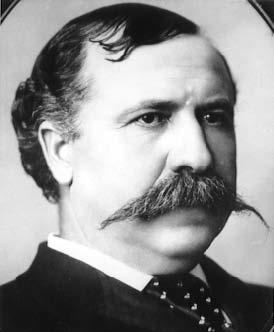Job A. Cooper
- Statehood Governor of Colorado from 1889-1891
- Party: Republican
View a description of holdings
Biography
Early Years
Job Adams Cooper, Governor of Colorado (1889 - 1891), was born in Greenville, Illinois, on November 6, 1843. He was one of seven children born to Charles and Maria (Hadley) Cooper, both of English lineages. Cooper earned both the Bachelor of Arts and Master of Arts degrees from Knox College in Galesburg, Illinois. In May of 1864, he took leave from school and headed for the battlefields of the Civil War. Enlisting in Company C, 137th Illinois infantry, commanded by Captain B.M. Veatch, Cooper was stationed in Memphis, Tennessee, when the Confederate General Forrest made his famous raid on that city. Later that same year, Cooper was mustered out and returned to Illinois to complete his studies in Galesburg. After completing coursework at Knox College, he returned to his hometown, Greenville. Cooper began to study law there, and in 1867 was admitted to the bar. There he operated a law practice which led to his appointment as Clerk and Recorder of Bond County, Illinois. On September 17, 1867, he married Jane O. Barnes, the daughter of a prominent Illinois minister. This union would bring four children: Olivia Denham, Mary Louisa, Charles J., and Genevieve Pearl.
Business Ventures
In 1872, Cooper and friend A. C. Phelps left their families in Illinois and traveled west to witness what various young towns had to offer entrepreneurs. On May 14, 1872 the two men arrived in Denver. On September 1, 1872, Cooper was admitted to practice law in Colorado, and later that same year he created a partnership with his friend, the law firm of Phelps and Cooper. Over the next few years Cooper would find interest in many walks of business besides law including fire insurance, banking, mining, and the cattle industry. The success he enjoyed with these various business ventures led to his gubernatorial nomination by the Republican Party in 1888.
Elected Governor
Cooper's opponent in that election was Thomas M. Patterson, editor of the Rocky Mountain News. Cooper received over ten thousand votes, and was inaugurated in January 1889 as the sixth governor of Colorado. His administration is credited with the creation of thirteen new counties (Baca, Cheyenne, Kiowa, Kit Carson, Lincoln, Montezuma, Morgan, Otero, Phillips, Prowers, Rio Blanca, Sedgewick, and Yuma), an orphans home in Denver, a compulsory school law, and a reformatory in Chaffee County. As a member of the Board of Capitol Managers during the design phase of the state's capitol building, it was Cooper that convinced the board to build with granite instead of sandstone, thus increasing the construction costs from one-million to upwards of two-point-five-million dollars.
On January 20, 1899, at the age of fifty-five, Governor Cooper passed away. His grave is located at Riverside Cemetery in Denver.
Bibliography
- Baker, John H., and Le Roy R. Hafen (eds.). History of Colorado. Vol. 5. Denver, CO.:Linderman,1927.
- Colorado and It's People: A Narrative and Topical History of the Centennial State. Volume I: Personal and Family History. New York: Lewis Historical Publishing Company, Inc., 1948.
- Fritz, Percy Stanley (Ph.D.). Colorado - The Centennial State. New York: Prentice-Hall, Inc., 1941.
- Goodstein, Phil. The Ghosts of Denver: Capitol Hill. Denver: New Social Publications, 1996.
- Hall, Frank. History of Colorado. Chicago: The S.J. Clark Publishing Company, 1918.
- Records of the Office of the Governor, Job A. Cooper, 1889 - 1891. Colorado State Archives.
- Rocky Mountain News, January 21, 1899, pages 1 and 10.
Scope and Content Note
The Job A. Cooper collection comprises 7 cubic feet of material and 1 microfilm roll which spans his term of office from 1889 - 1891. Major series include the Executive Record, correspondence, reports, speeches and messages, and State Board of Equalization minutes (1890-1897). While the collection is relatively small, Cooper's official acts can be documented through the Executive Record while other aspects of his administration can be documented through the correspondence and the reports. The State Board of Equalization minutes are valuable documentation of the state's assessment on property, railroads and businesses before the turn of the century.
Series Descriptions
- Executive Record
The Executive Record contains: executive orders, appointments, legislative messages, pardons, letters of extradition and requisition, honorary citations, and proclamations that were issued by Governor Cooper.
- Correspondence
Includes general correspondence, telegrams, warrants, rewards for the capture of convicts, various petitions, and general miscellany. Subject matter includes an investigation of the State Women's Hospital in 1889, Indian Affairs, and correspondence with the Attorney General's Office concerning appropriations and incorporating towns.
- Speeches and Messages
Cooper's Inaugural Address (1/1889) and the Biennial Message to the 8th General Assembly (1/7/1891).
- Reports
Primarily this segment consists of reports filed with the governor by various state agencies. Included is the "Report of the Commission to Revise the Laws of the State Regulating the Appropriation, Distribution, and Use of Water" and a report concerning immigration into Colorado.
- Minutes of the Board of Equalization
This series consists of one volume of the State Board of Equalization Minutes from 1890-1897.
To Request a Record
To search our records, please see Archives Search.
To request a record from the Archives, please submit a formal request.
- See also our associated fees
